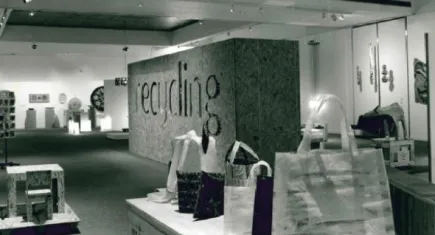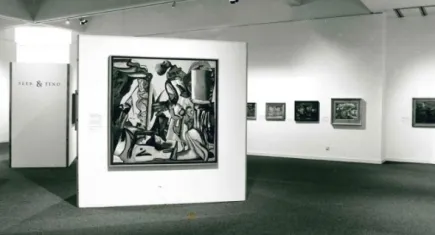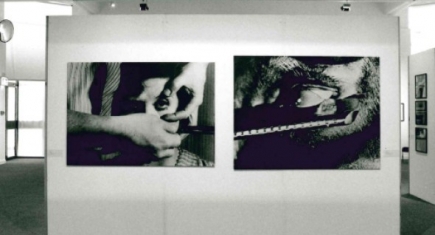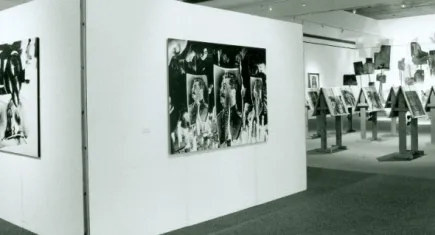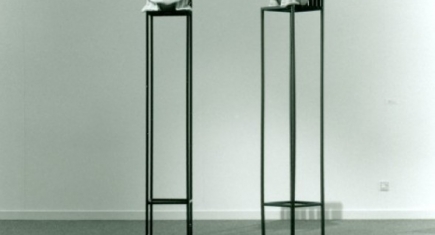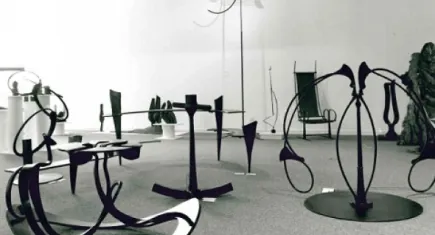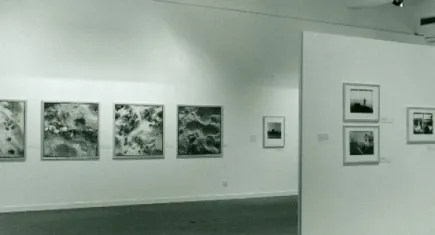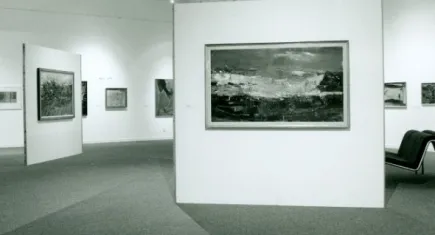Mead Gallery Exhibitions 1996
Re:cycling, Forms for the Next Century; Austerity for Posterity
A Craftspace Touring Exhibition
Sat 9 Nov – Sat 7 Dec 1996
Seek and Find
St Andrew’s Benn School Curates the Rugby Borough Council Collection
Sat 2 Nov – Sat 7 Dec 1996
In March 1996 the Mead Gallery invited a class of Year 5 students from St Andrew’s Benn Primary School in Rugby to curate an exhibition from the Rugby Borough Council Art Collection. The Collection is housed and cared for by the University of Warwick and shown annually in the Mead Gallery.
“Our school was privileged to be able to curate an exhibition at the Mead Gallery. Our aim was to go through a process which would give every child in Year 5 the opportunity to collect, analyse and organise relevant information from a rich source of works of art. They were encouraged to make a personal response and then develop this to be able to express and justify their opinions. This led them to listen to each other’s views andmodify their ideas to suit the agreed selection criteria for the exhibition.
“The exciting aspect of this project is that although the seeds were germinated in the classroom, they grew into reality. A huge, real, beautiful art gallery became the working environment and a collection of admired works of art became the source. The children were entrusted with a public place of high status and given a valuable collection to consider. We did not underestimate their ability or expect too much. They worked so hard.
“The challenge tested their knowledge, skills, concepts, emotions. They have grown enormously from this project. So have I!”
Carol Etherington, Head Teacher, St Andrew Benn’s Primary School
We chose from lots of paintings those that looked as if they could have been seen by looking out of windows. We also had to choose one painting for the poster and the invitations. It took us a long time. We had to choose which ones fitted the theme the best and say why the paintings should be in the exhibition. One of my paintings was not included and I felt a bit upset when it was not used. I could see why it would not fit in when we discussed it.
Carly Plucinski
Man, Dog, Snake and Bird by Ken Kiff
Four fingers of orange fire
Four friends hiding, waiting for the fire to go,
to escape in the boat
They need to work together to think of a plan.
Kamran Malik
The Blue Lamp by JD Fergusson
I think the artist who painted The Blue Lamp was trying to show us how you can use a title for a painting. It doesn’t matter if it’s the smallest or largest thing in the painting; it will still attract people to the painting whatever age they are.
It makes you look more carefully to see if the object in the title is on the painting. When I first saw the painting I thought, why did the artist call it The Blue Lamp because the biggest thing on the painting is a big wodge of fruit! Why didn’t the artist call it ‘Lovely Bowl of Nutritious Fruit’?
I like this painting because it made me think about all the colours he had used.
Jamie Clark
Exhibition leaflet sponsored by Rugby Cement
The Mead Gallery would love to hear from any of the children, now adults, who took part in this project. What did it mean to you?
Robert Adams
Neil Allan, Jane Andrews, Alice Bannigan, Bryony Best, Fiona Bloxham, Kathleen Breen, David Buckby, Samuel Busch
Alisha Carter, Jame Clark, Jessica Dick, Matthew Ingram, Radhica Joshi, Faruq Kasu, Martin Lewis, Jodie Lines, Aisha Magrey, Kamran Malik, Ajlan Mohammed, Carly Plucinski, Adam Rathod, Holly Robertson, Yasin Siddiqui, Alex Szrok, Rikesh Tailor, Laura Walker, Daniel Wilson
Class Teacher: David Espin
The Director's Eye: Drawings and Photographs by European Film-makers
Exhibition organised and toured by the Museum of Modern Art, Oxford
28 Sep – 26 Oct 1996
Exhibition review
Kevin Jackson, The Independent, Sunday 25 February 1996
Most film buffs will not associate Sergei Eisenstein with farting jokes, jokes about oversize penises, or indeed with lavatory humour in any of its forms. But the optical proof is beyond dispute: sometime around 1930, the director of Battleship Potemkin and October saw fit to cut out a newspaper story headlined “Antique Roman Organ Found”, paste it to a scrap of paper and scrawl around it a knockabout cartoon depicting a dirty old Roman who has snapped off his gigantic virile member at the root and is displaying it as gleefully as if it were Trajan’s column. Lower down, Eisenstein stuck a paragraph from the same story sub-headed “Music of the Spheres” and decorated it with a pair of trumpeting buttocks.
More surprising still are the wildly uncensored doodles Eisenstein was producing at roughly the same time. One shows a naked woman, curved into a half-moon with monstrous flowers sprouting from her pudenda; another a neatly coiffured male angel with a bird’s head for genitals. These little cartoons were never meant for public exhibition – they were jotted down on cheap bits of paper, sometimes sent as letters to friends – but that is not to say they are not worth exhibiting, as Oxford’s Museum of Modern Art has now chosen to do for “The Director’s Eye”, the first of two shows marking the centenary of British cinema. As evidence of a restless, febrile temperament, they are at once warmer and weirder than his canonical films; as graphic expressions, they hint at the kind of strange erotic images Eisenstein might have brought to the screen had he died later and Stalin sooner.
Few of the exhibits here are as intimate or as disconcerting as Eisenstein’s doodles, but most of them were similarly unassuming in origin. In reconstructing a few of the many, often recondite links between European art and European cinema, the show’s co-curators Ian Christie and David Elliot have concentrated on the sketches, paintings and photographs that tend to foam out in the wake of movies as they move from page to screen. Pace the title, the eyes which are celebrated here belong as often to production or costume designers as to directors: Paul Leni’s sketches for films by Lubitsch; John Armstrong’s costume drawings for the British sci-fi epic Things to Come; John Beckman’s tightly plotted set-plans for Chaplin’s Monsieur Verdoux.
What the exhibition really brings home, though, is how seldom such working sketches could ever have been merely functional in intent: again and again, you’re struck by the energetic excess of detail in, say, William Kellner’s sombre drawings for The Lavender Hill Mob, or – probably the most extraordinary pieces of their kind here – Alexandre Benois’s brooding watercolours of the cavernous interiors for Abel Gance’s Napoleon. Benois’s devotion to the assignment is not only manifest in the intricacy of his work but in the angry phrase he scrawled across the back of one after viewing Gance’s completed film: “This scene was ruined by the so-called demands of cinema!”
The artist-directors themselves are represented in a variety of media: Cocteau and Bunuel/Dali by familiar stills from Le Sang d’un Poete and Un Chien Andalou, Man Ray by a “Rayogram” sequence from Le Retour a la Raison, and the abstract film-maker Len Lye by a collection of the strips of celluloid onto which he would paint coloured patterns. Strictly speaking, Lye was a New Zealander and thus outside the show’s European remit, but he sneaks in because so much of his work was done here; similarly, drawings by the Disney Studios and a sequence of Wile E Coyote sketches by the great Chuck Jones are allowed to slip through EU customs since it was the French surrealists who first sounded their artistic merits. Only a sourpuss would object.
For the rest, there is a generous helping of Powell & Pressburger material, including a few (more than faintly kitsch) production paintings for The Red Shoes and The Tales of Hoffmann by Hein Heckroth, and plenty of Powell’s own, often very good photographs: the funniest image in the exhibition shows David Niven, armed with bow and arrow, hurling himself sideways into a swimming pool clad only in trunks, deerstalker and a mad grin. The exhibition closes with a strong representation of paintings, collages and the like by recent British and honorary British artist-directors – Derek Jarman, Bill Douglas, Terry Gilliam, Peter Greenaway, Sally Potter and Alan Parker – as well as predictably sexy cartoons by Federico Fellini, and Satyajit Ray’s delicately uncanny drawing of an alien’s head for the sci-fi film he never made.
Peter Kennard: UNWORDS – Scraps from a Reading Room
28 Sep – 2 Nov 1996
Peter Kennard, one of the most important political artists working today, looks at events in 1995 through the words of the United Nations and the financial pages of newspapers. UNWORDS questions whether the barbarism of the global system can be addressed through the words of the UN, words which in themselves aspire to democracy and freedom. The words and numbers of the financial pages aspire to a very different kind of freedom, that of the market.
Kennard demonstrates that it is this which determines the function of the UN and it is this that the UN is bound to protect. In the face of price indexes and market reports words become UNWORDS and the protective language of the UN becomes no more than empty rhetoric masking the reality of the economic and financial imperatives of the market place.
As the struggle for human rights becomes buried by the share prices, the politicians do not even appear on these pages, their absence symbolising their collusion with the multinationals and the international banking system. In the final section of UNWORDS, hands, though damaged and submerged under layers of print, continue to claw, tear and rip at the pages.
Permindar Kaur: Cold Comfort
25 May – 29 Jun 1996
Permindar Kaur removes the domestic and the familiar from their everyday surroundings and transforms them to produce disquieting results. The experience of her work can be unnerving, like visiting a deserted house or an abandoned institution. Feelings of containment and anxiety are explored through figures and objects, some of which are enticing in their sensual beauty while others produce feelings of entrapment.
She has always been particularly interested in relating her work to the site in which it is placed. Ikon Gallery, as part of its policy of giving artists opportunities to make new work, has therefore commissioned her to make a new installation for the gallery. The artist’s response to the space reflects her continuing interest in the domestic environment. The tall bed structures, placed in the white walled gallery, subvert notion of privacy, intimacy and comfort. A thought provoking twist is given to mundane domesticity.
The works on show at the Mead Gallery maintain a sense of subversion. They include work made in Spain last year as well as more recent work made on the artist’s return to the United Kingdom. The installation is part of a series of exhibitions, commissions and residencies at Warwick Arts Centre designed to encourage and promote new work across a variety of art forms and across different venues. We hope that visitors will take the opportunity to visit both parts of the exhibition, which together provide an overview of Permindar Kaur’s recent work.
We are very grateful to Jose Lebrero Stals and Claire Doherty for their perceptive essays, to the Arts Council of England for support for the catalogue through the Artist’s First Time Publications Scheme and to Traditional Structures Ltd for providing the steel for the Ikon installation. The artist would like to thank Nicholas Lister from Arc Studios, Simon Withers and Kamay Kaur. Above all we must thank the artist for her commitment to this ambitious project and for the energy and thoughtfulness she has brought to it.
Elizabeth Ann Macgregor and Sarah Shalgosky
Fe: An Exploration of Iron Through the Senses
Organised and toured by the British Artist Blacksmiths Association
Sat 20 April – Sat 18 May 1996
Fe – an international exhibition of new contemporary iron work organised by members of the British Artist Blacksmiths Association (BABA), toured ten public art galleries throughout Britain during 1995-96.
Green Fuse: New Sculpture by David Nash
A Mead Gallery Exhibition
Sat 20 Apr – Sat 29 Jun 1996
David Nash was first approached with the idea of working at the Mead Gallery in the Autumn of 1994. Place is a very important element in David’s work and we began looking a trees on the university campus, focusing on Tocil Wood where there was a number of dying oaks.
An approach was made to the Warwickshire Wildlife Trust as managers of the wood and a meeting arranged with the then conservation manager Neil Wyatt. It quickly became apparent that dying trees support a rich variety of insects, fungi and other wildlife and are as important to the life of a wood as healthy trees. Nevertheless, Neil pointed out that other reserves did have trees marked for felling as part of benign management schemes. Extensive thinning of oak was being carried out at Ryton Wood with several large trunks having already been cut. A long neglected coppice of alder at Stonebridge Meadows presented David with the opportunity to work with the fresh vibrant colouring of this wood that he had enjoyed in Otoineppu, Japan. Finally a large beech tree was to be removed from Clowes Wood so the sunlight would be able to penetrate deeper into the adjacent water meadow.
David Nash worked in the University of Warwick Estates yard with Mead Gallery technician Ashley Wright as his assistant. The oak formed egg and tower shapes, the alder became a spreading circular form of individual stumps, the beech was cut into thin wafers that hung high on the gallery walls.
Going West: Photographs from Western Australia
10 Feb – 16 Mar 1996
A Mead Gallery Exhibition curated by Victoria Pomery, Assistant Curator of the Mead Gallery on her recent three month exchange visit to the University of Western Australia.
This exhibition presents a visitor’s view of “Australianness”. Featuring black and white photographs by a number of contemporary Australian artists, the portraits, landscapes and images of suburban life challenge the perceptions that are formed about Australian culture through the British media.
Willy Ronis: Photographs 1926-1995
Organised and toured by the Museum of Modern Art, Oxford
Sat 6 Jan – Sat 16 Mar 1996
A contemporary of Henri Cartier-Bresson and Robert Doisneau, Ronis is a leading figure in the development of French humanist photography. His work spans numerous key historical moments and often reflects or anticipates the attitudes and aspirations of the time. His studio is the street and his talent is to convey a whole way of life. He sees and photographs people and places as they are and not how others perceive them to be. His profound understanding of his subject makes the work both accessible and thought-provoking.
Still active at 84, his work has been hugely influential yet has remained little known outside France. This retrospective exhibition will present 200 of Ronis’ photographs, tracing his life and influences. The exhibition will show the diversity of his work: social reportage, political documentary, the people of Paris, the people and landscapes of Provence, Limousin, Holland, Germany and Italy.
The exhibition includes both vintage and modern prints.
In 1998, the University of Warwick awarded Willy Ronis an honorary degree.
Earthbound: Landscape to Abstraction
Paintings from the Rugby and Kettering Collections
Sat 6 Jan – Sat 3 Feb 1996
A Mead Gallery Exhibition, curated by Amanda Daly, Assistant Curator of the University of Western Australia Art Collection, during her recent exchange placement at the Mead Gallery.
‘Earthbound’ explores the movement from landscape to abstraction in mid-twentieth century British painting and features artists such as Joan Eardley, Paul Nash and Graham Sutherland.
Many of the paintings are entirely abstract, yet still express the artists’ personal responses to the landscape. The exhibition traces the departure from representational to abstract images of the environment and investigates the artistic movements that influenced this shift.
‘Earthbound’ examines how this artistic progression is evident in two public art collections – those of Rugby and Kettering Borough Councils.

